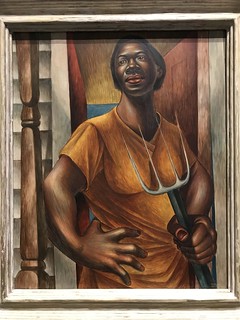Today at LACMA I became acquainted with an extraordinary artist I had not known before. Charles White (1918-1979)
was an African-American artist who grew up in Chicago during the Depression, but also lived in New Orleans, New York, Mexico City, and ultimately Los Angeles. He worked in a variety of paintings, murals, graphic print works, woodcut, with influences ranging from WPA projects to Diego Rivera and Soviet social realism, all filtered through his own distinctive African-American experience. His subjects are always human figures, generally very expressive, evocative, soulful. A woman with a pitchfork stands on her porch in “Our Land”, like a black American Gothic, a look of satisfaction in her hard work. A man and woman show utter hopelessness in “There Were No Crops This Year”. White served in WWII, and a couple of the works showed the complex feelings of black soldiers, proud to serve their country but uncertain whether their country would return their respect. Many works show iconic figures like Harriet Tubman and Frederick Douglass, often with imagery of Old Testament prophets, pointing the way to the promised land. I lingered over so many of his works, captivated by their emotional power and their visual dynamism. Interestingly, before I entering this exhibit, I visited the sculpture garden to see some of my favorite works by Rodin, and with those works fresh in mind I saw many similarities with White’s paintings: powerful evocative human figures, dramatically oversized hands, the same ennobled despair and resolution chiseled into faces. I don’t know if White would have ever seen Rodin’s Burghers of Calais, but his take on the 20th century African-American experience would have an interesting dialog with those 14th century French victims of the Hundred Years War sculpted by Rodin. (See complete pics from my visit to LACMA.)
Friday, March 15, 2019
Subscribe to:
Post Comments (Atom)





No comments:
Post a Comment